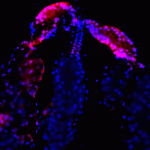Link to Pubmed [PMID] – 27304978
PLoS Genet. 2016 Jun;12(6):e1006111
Due to their error-prone replication, RNA viruses typically exist as a diverse population of closely related genomes, which is considered critical for their fitness and adaptive potential. Intra-host demographic fluctuations that stochastically reduce the effective size of viral populations are a challenge to maintaining genetic diversity during systemic host infection. Arthropod-borne viruses (arboviruses) traverse several anatomical barriers during infection of their arthropod vectors that are believed to impose population bottlenecks. These anatomical barriers have been associated with both maintenance of arboviral genetic diversity and alteration of the variant repertoire. Whether these patterns result from stochastic sampling (genetic drift) rather than natural selection, and/or from the influence of vector genetic heterogeneity has not been elucidated. Here, we used deep sequencing of full-length viral genomes to monitor the intra-host evolution of a wild-type dengue virus isolate during infection of several mosquito genetic backgrounds. We estimated a bottleneck size ranging from 5 to 42 founding viral genomes at initial midgut infection, irrespective of mosquito genotype, resulting in stochastic reshuffling of the variant repertoire. The observed level of genetic diversity increased following initial midgut infection but significantly differed between mosquito genetic backgrounds despite a similar initial bottleneck size. Natural selection was predominantly negative (purifying) during viral population expansion. Taken together, our results indicate that dengue virus intra-host genetic diversity in the mosquito vector is shaped by genetic drift and purifying selection, and point to a novel role for vector genetic factors in the genetic breadth of virus populations during infection. Identifying the evolutionary forces acting on arboviral populations within their arthropod vector provides novel insights into arbovirus evolution.

